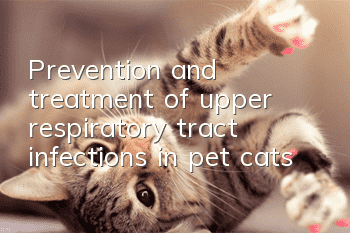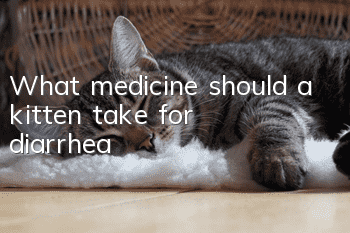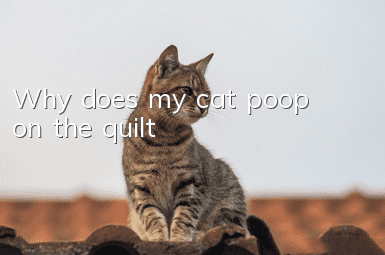Prevention and treatment of upper respiratory tract infections in pet cats

Upper respiratory tract infection (uri), as a highly contagious infectious disease, has a high incidence rate in young cats. For every cat-raising family, it is essential to take measures to prevent the occurrence of URI. If there are few, then to prevent and treat upper respiratory tract infection in cats, we can start from the aspects of residence, polluted air, poor sanitary conditions, stress, complications, parasitic infection, and malnutrition based on its transmission route.
1. Reduce stress
Efforts to reduce stress must begin and continue from the moment the cat is brought back, because sometimes even a simple cage change is enough to induce URI in some cats. Keeping everything as clean and hygienic as possible and providing housing that does not require extensive moving or cleaning is key to controlling cat URIs. Regrouping cats that live in groups has been linked to the recurrence of URIs. If group housing is necessary, it is more advantageous to use smaller groups than larger groups to minimize the frequency of cats moving in and out.
If you need to keep them separately, it is better to divide them in a large room. Considering that cats need places to hide, reducing ambient noise (especially barking dogs), maintaining a light-dark cycle and a comfortable temperature, and providing toys and scratchable surfaces are also important to relieve cat stress. Unnecessary treatments should be kept to a minimum - handling or force-feeding that may be aversive to the cat must be weighed against the stress caused by these procedures. Increased socialization may help relieve stress and stress in cats, but it must be done judiciously.
Taking a cat out of the cage and being carried by a stranger into an unfamiliar room may help relieve boredom in some cats, but in other cats it may cause intense stress (and also make it easier for cats to play). spread of certain diseases). Owners should learn to observe the cat's reaction to interactive activities and do things such as grooming or petting in the cage, or letting the cat play in a clean, quiet area outside the cage or letting the cat sit on their lap (healthy vaccinations only) For vaccinated cats) etc.
2. Disinfection
Most URI pathogens survive in the environment from a few hours (e.g., FHV-1) to a few weeks (e.g., Boscherii) and can be inactivated with conventional disinfectants. When an FCV outbreak is suspected, strict attention to disinfection is required. Household bleach (5% sodium hypochlorite) diluted 1:32 when applied to clean surfaces can inactivate calicivirus. Likewise, other items used in households as bleach such as calcium hypochlorite and sodium dichloroisocyanurate (Eclozin) have also been shown to be effective at killing non-enveloped viruses. Like bleach, these products without detergent properties must be used to clean the surface before cleaning. Other proven disinfectants include potassium peroxymonosulfate and fast-acting hydrogen peroxide, these two agents are reported to have stronger decontamination capabilities and better bactericidal activity on organic surfaces than other bleaches and their related products. Numerous independent studies have repeatedly demonstrated that quaternary ammonium disinfectants are not reliably effective at killing non-enveloped viruses, despite repeated claims and labeling of such products as being effective.
Calicivirus also cannot be reliably inactivated by alcohol-based disinfectants, and hand sanitizers commonly used in shelters may not be completely effective against calicivirus (although they should still be used in all animal housing to protect public health) . Disinfectants containing 60 - 90% ethanol and propanol are more effective against calicivirus than other alcohol-based disinfectants. As mentioned above, the stress and risk of contaminant dispersion from cleaning a typical box-style single cat carrier may outweigh the benefits of thorough disinfection. If possible, the cat carrier should be cleaned in the area where the cat lives, and the cat carrier should be thoroughly cleaned, disinfected and dried between cats.
In short, the prevention and control of infection mainly relies on proper feeding and management. The basic principles are to use a well-controlled and well-ventilated environment to minimize emergencies and to dilute emerging pathogens to the lowest contact concentration. Newly introduced Adult cats or kittens should be isolated and observed for at least two weeks, because the female cat may become a carrier and it is not easy to detect. Therefore, it is best to wean the kittens at 4 weeks of age; each cat cage should be separated by at least one meter. And there are barriers, gloves should be worn when handling cages, and gloves must be changed or disinfected before use in each cage.
3. Residence
Good housing conditions, reduced stress, a sense of security, and effective cleaning and hygiene are complementary to each other in promoting cat health. A good home has a direct impact on the health of cats, and is conducive to cleaning and relieving cat stress. Housing conditions may be the single most important factor in the incidence of URI in rescue shelter cats. A recent study showed that only 60 of 1,434 cats sent to rescue shelters in the UK developed URIs while staying at rescue shelters. The cats in this study generally live in large rooms at rescue stations, and can freely enter and exit the indoor/outdoor areas separated by upper and lower retractable doors. The cats are provided with sufficient hiding space, separated garbage and food, and are completely isolated. Noise from barking dogs, and constant care, etc.
4. Treatment methods
Symptomatic and supportive therapy should be adopted for cats with acute illness, especially those with acute illness should be given adequate water and nutrients. When rehydrating sick cats, adding an appropriate amount of thymosin can improve the body's immunity and enhance disease resistance. Pay attention to frequently clearing the secretions from the nasal cavity and eyes of the affected cat. You can use spray or saline to help clear purulent secretions. In addition, vasoconstrictor drugs such as 0.25% epinephrine hydrochloride can also be used for intranasal instillation to reduce the amount of serous mucus secreted in the nasal cavity, but it is not suitable for patients with mucopurulent dissection.Sick cat with discharge. Use broad-spectrum antibiotics to prevent secondary infections. Ampicillin is the first choice, 10 to 20 mg/kg body weight, intramuscular injection or oral administration, 2 to 3 times a day. This type of antibiotic has few clinical side effects and is suitable for the treatment of young cats.
If the cat is suspected of having mycoplasma infection, doxycycline can be used, 5 to 10 mg/kg body weight, orally once every 12 hours. For conjunctivitis caused by chlamydia, chloramphenicol or tetracycline ointment can be used, which should be used at least 4 times a day and should be continued for 2 weeks after the clinical symptoms disappear. Corneal ulcers caused by infectious rhinotracheitis virus can be treated with antiviral eye drops such as trifluridine or acyclovir eye drops, used every 2 hours, and antibiotic eye drops are used alternately. Taking 250 mg of lysine orally, twice a day, can interfere with the replication of herpes viruses and reduce the severity of infectious rhinotracheitis. You can also intramuscularly inject 0.2 to 0.4ml of Polymusk, once every other day, to inhibit the herpes virus.
- Why do kittens always have gum in their eyes? What should I do?
- How to get rid of bad breath in cats
- How many kg is 7L of cat litter?
- Why doesn’t a cat like people touching its ears? A must-read for cat lovers!
- How to improve cat hair problems?
- What does it mean when a cat suddenly shows its belly to you?
- Why is the cat too thin?
- The cat's eyes are moist as if they are crying
- How often does a cat go into heat?
- Cat vomits yellow water with foam and is not energetic and refuses to eat



